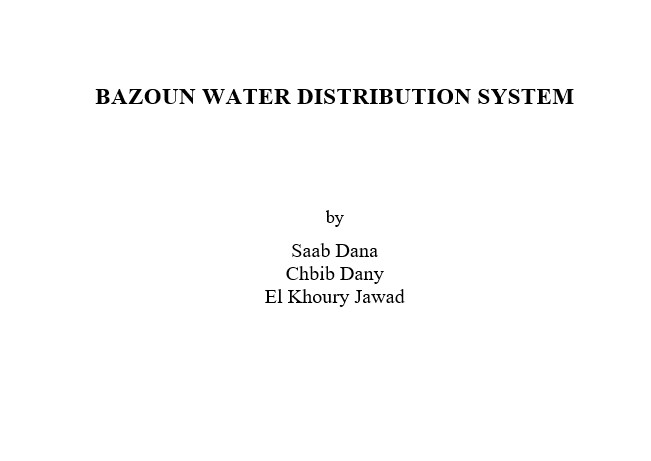Bazoun Water Distribution System
 |
rapport May 2023 ; 102 pages
Aut.
Ed. USEK - Jounieh
Téléchargeable sous format: PdF
Abstract:
Objective of the project
1.2.1. Main objective
Our project revolves around this topic. How can we improve the water network in Lebanon? What can be done to limit water losses in WDSs?
This project aims to design a water distribution system to a region in Lebanon, improving the water supply network, both in quality and quantity.
1.2.2. Specific objectives
The specific objectives of this project are as follow:
• Design a water distribution system that includes the design of all its components; pipes, tank, valve etc., test the system on all scenarios.
• Transform the system into a GIS model which is the system that will be used for capturing, storing and displaying the data of the model. Contents:
CHAPTER 1. GENERAL INTRODUCTION 10
1.1. Overview 10
1.2. Objective of the project 12
1.2.1. Main objective 12
1.2.2. Specific objectives 12
1.2.3. Software used 12
1.3. Summary of the Project 12
CHAPTER 2. RELATED LITERATURE REVIEW 14
2.1. Overview of the Water supply network 14
2.2. Sources of water 15
2.3. Water distribution systems 16
2.3.1. Types of distribution systems 16
2.3.2. Network configurations 18
2.3.3. Water supply types 20
2.4. Pipes 20
2.4.1. Types of pipes 20
2.4.2. Types of pipe material 21
2.4.3. Selections of pipe 23
2.5. Valves 23
2.5.1. Types of valves by their functions 23
2.5.2. Types of valves by their configurations 25
2.6. Fire Hydrants 27
2.6.1. Types of Fire Hydrants 27
2.7. Water Storage 28
2.7.1. Configuration of Water Storage 28
2.7.2. Type of material in water tanks 30
2.8. Pumps and pumping stations 30
2.8.1. Centrifugal pumps 30
2.9. Water distribution system design 31
2.9.1. Overview 31
2.9.2. Design criteria 31
2.9.3. Water demand 37
2.10. System analysis 39
2.10.1. Steady State Simulation 40
2.10.2. Extended Period Simulation (EPS) 40
2.10.3. Peak factors 40
2.10.4. Multipliers 41
2.11. ArcGIS 41
2.11.1. ArcGIS Overview 41
2.11.2. Advantages of Building a GIS Model 42
2.12. Smart Water System 43
2.12.1. Overview 43
2.12.2. Real and Apparent Losses 43
2.12.3. Causes of Real losses in the WDS: 44
2.12.4. Consequences of leakage: 44
2.12.5. Advantages of Smart water network 44
2.12.6. Basics of Smart Water Network 45
2.12.7. The SWN framework 45
2.12.8. Smart Water Network Projects Examples 47
2.13. Monitoring Methods in SWN 48
2.13.1. Automated Meter Reading (AMR) 48
2.13.2. Advanced Metering Infrastructure (AMI) 49
2.13.3. Supervisory Control and Data Acquisition (SCADA) 50
2.14. The DMA Concept 50
2.14.1. DMA Concept Criteria: 51
2.14.2. Water Balance 52
2.14.3. Minimum Night Flow (MNF) 53
2.15. Conclusion 54
CHAPTER 3. PROJECT SITE ANALYSIS 55
3.1. Geography and topography of Bazoun 55
3.1.1. Longitude & Latitude of Bazoun 55
3.2. Land Occupation plan 56
3.3. Population Analysis 57
3.3.1. Population growth 57
3.3.2. Population forecasting calculation 58
3.4. Existing situation of the water system in Bazoun: 59
CHAPTER 4. WATER DISTRIBUTION DESIGN ANALYSIS 60
4.1. Data Collection 60
4.2. Preliminary Layout of the WDS 61
4.2.1. Layout of the Junctions 61
4.2.2. Choice and Layout of the Pipes 61
4.2.3. Classification of the Junction into zones 62
4.2.4. Thiessen Polygons 63
4.3. Determination of the Peak Factor: 64
4.4. Calculation of the Water Demand 65
4.5. Calculation of the Pipe Diameter 67
4.5.1. Unification of the pipe diameter 68
4.5.2. Pipes Cover 69
4.6. Design of the Water Tank 69
4.6.1. Water Tank 1 70
4.6.2. Water Tank 2 71
4.6.3. Choice of Tank Dimensioning and Location 72
4.7. Extended Period Simulation 73
4.7.1. Water Demand in EPS 73
4.7.2. EPS Results and Solutions 74
4.8. WaterCAD results – Flex tables 77
CHAPTER 5. GIS MODELLING USING ARCMAP 78
5.1. Georeferencing of the WDS 78
5.2. Geodatabase 78
5.2.1. Bazoun Network 78
5.2.2. Bazoun data 85
5.2.3. Smart Water Network 86
CHAPTER 6. SMART WATER NETWORK 90
6.1. District Meter Area (DMA) 90
6.2. Monitoring System 90
6.3. Scenario 1 – Leakage at DMA-1 using MNF 90
6.4. Scenario 2 – Leakage at DMA-1 using Water Balance 92
6.5. Scenario 3 – Contamination in the System 92
CHAPTER 7. COST ESTIMATION - BOM 94
7.1. General Overview 94
7.2. Cost Estimation 95
7.2.1. WDS instruments 95
7.2.2. Tank 96
7.2.3. Pipes 98
7.2.4. Total Cost Estimation 99
CHAPTER 8. CONCLUSION 100
REFERENCES 102
Public-Cible:
Mots clefs: |
accès à l'assainissement (CI) (DT) (OP) (ope) , accès à l'eau (CI) (DT) (OP) (ope) , collectivité locale (CI) (DT) (OP) (ope) , maintenance, entretien (CI) (DT) (OP) (ope) , maîtrise d'ouvrage (CI) (DT) (OP) (ope) , potabilisation (CI) (DT) (OP) (ope) , projet (montage, gestion) (CI) (DT) (OP) (ope) , services essentiels (CI) (DT) (OP) (ope) |
Pays concerné: |
Editeur/Diffuseur: |
|
USEK
-
Université Saint-Esprit de Kaslik - Jounieh - Liban |
En cas de lien brisé, nous le mentionner à communication@pseau.org